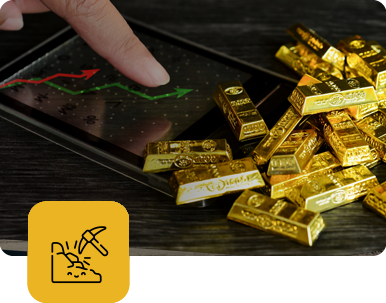Commodities

Commodities are traded on specialized exchanges like the Chicago Mercantile Exchange (CME) and the New York Mercantile Exchange (NYMEX). They’re often used as a hedge against inflation, and their prices can be volatile due to factors like weather, geopolitical events, and changes in supply and demand.
1 . What is Commodities Investment?
- Introduction to Commodities Investment
A beginner-friendly guide explaining what commodities are, how they fit into an investment portfolio, and why investors consider them for diversification. - Commodities vs. Stocks: Which is Better for Your Portfolio?
Compare commodities with more traditional assets like stocks or bonds. Highlight how each performs under different market conditions, like during inflation or economic downturns.
2 . Types of Commodities to Invest In
- Hard Commodities: Metals and Energy
Focus on precious metals (gold, silver) and industrial metals (copper, aluminum) as well as energy resources like oil, natural gas, and renewables. - Soft Commodities: Agriculture and Livestock
Dive into agricultural commodities such as corn, wheat, coffee, cotton, and livestock like cattle and hogs. Discuss their seasonality and price volatility. - Alternative Commodities
A lesser-known area for investment: things like timber, water rights, and carbon credits. Investors are increasingly looking at these as a way to diversify further.
3 . How to Invest in Commodities
- Direct Investment vs. Indirect Investment
Explain the two main ways to invest in commodities: directly (buying physical commodities) vs. indirectly (using ETFs, futures contracts, or commodity stocks). - Futures Contracts Explained
A detailed guide on what commodity futures are, how they work, and why they’re used by both hedgers and speculators. - Commodity ETFs and Mutual Funds
Provide a breakdown of commodity ETFs, such as those tracking the price of gold, oil, or agricultural products. Show how these ETFs offer an easy entry point for retail investors. - Stocks of Commodity-Producing Companies
Discuss the option of investing in companies that produce commodities, like mining or energy companies, rather than the commodities themselves.
4 . Risks of Commodities Investment
- Market Volatility
Commodities can be highly volatile, with prices often influenced by unpredictable factors like geopolitical tensions, weather events, and supply-demand imbalances. - Leverage in Commodity Trading
Many commodity investors use leverage, which amplifies both potential gains and losses. Discuss the dangers of leverage and its impact on investment. - Currency Risk
Commodities are often priced in U.S. dollars. Explain how fluctuations in the dollar can affect the value of commodity investments for non-U.S. investors. - Political and Geopolitical Risks
Detail how events like OPEC decisions or government regulations can affect commodity prices.
5 . Strategies for Commodities Investment
- Long-Term Commodity Investment: Gold as a Hedge
Focus on using gold and other precious metals as a hedge against inflation and economic instability, especially during times of financial uncertainty. - Short-Term Trading and Speculation
Discuss more active trading strategies using futures contracts, options, or day trading to capitalize on short-term price fluctuations. - Diversification: Why Commodities Should Be Part of Your Portfolio
Explain how commodities help balance out other assets in an investment portfolio, acting as a hedge against stock market volatility and inflation.
6 . Commodities Market Trends and Future Outlook
- 2025 Commodities Forecast: What’s Next?
Analyze current trends and predictions for key commodities like oil, gold, and agricultural products over the next few years, based on economic factors and market behavior. - Green Energy and the Future of Commodity Investing
With the rise of renewable energy, explore how shifts toward clean energy are influencing investments in commodities like lithium, cobalt, and copper, which are essential for electric vehicle batteries.

